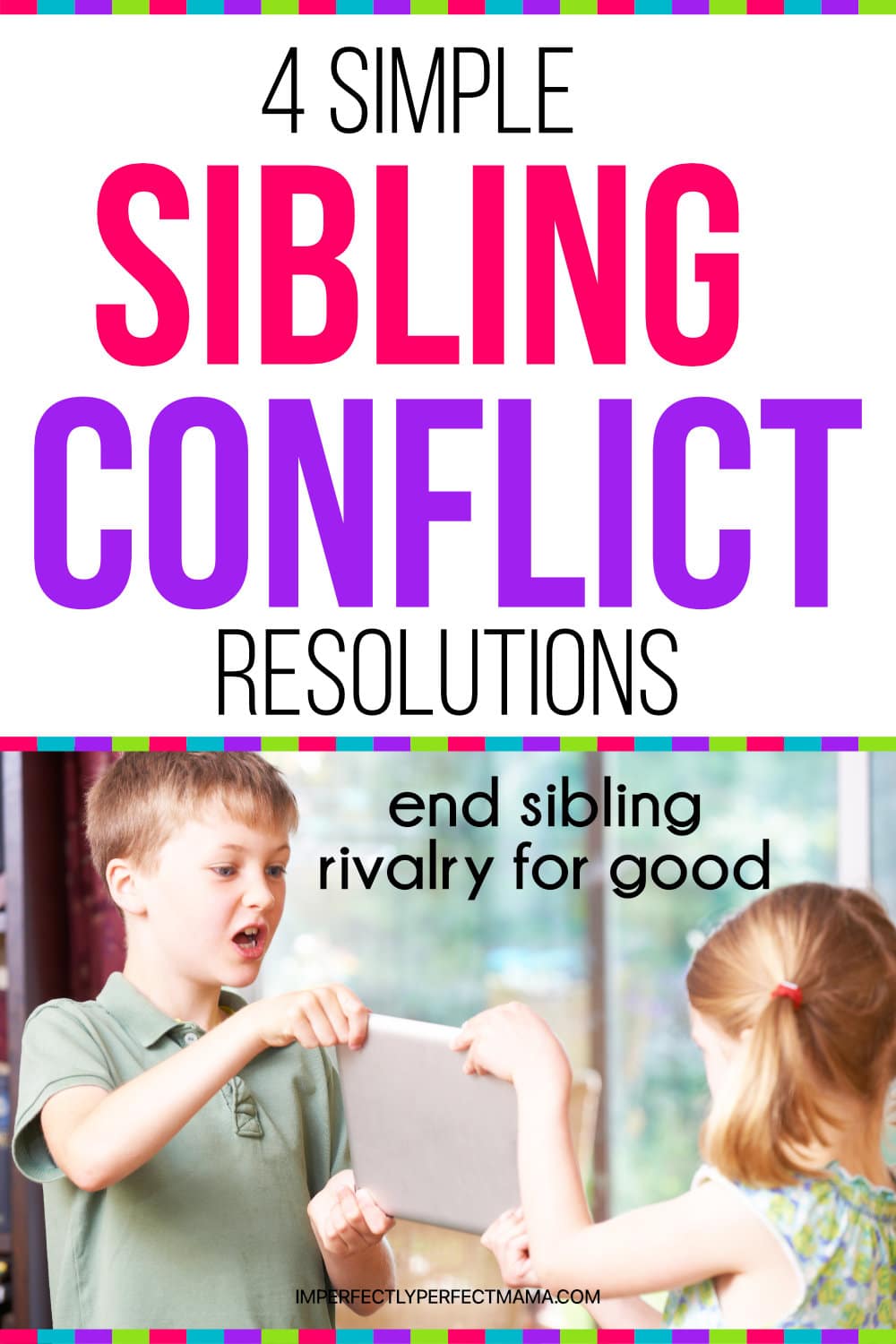Sibling conflict, sibling rivalry, sibling fighting – these prickly interactions between siblings are so common there’s more than one way to describe it!

But whatever you call it, every family with more than one child experiences it.
So if you have two plus children, I am sure you’ll find what you’re looking for in this article to help you with those sibling conflict resolution activities.
Because once the kids are home from school, hearing your children fight all day will make you want to find activities on sibling conflicts for children fast!
In this article, I will share evidence-based advice and guidance, as well as first-hand experience of putting the science to the test.
What Giving Your Child a Sibling Means: A Built-in Best Friend (Oh, and an Arch-Rival)
Oh, the excitement of having your second (or third or fourth) child, knowing that you are giving your children the best gift: a built-in best friend.
You just know they will love each other so deeply and you are over the moon to give your child “somebody to play with!” And while, yes, that’s true a lot of the time (and when it is, it’s glorious!), your child will also now have somebody to bicker with, pick on, annoy to no end, and occasionally use as their personal punching bag. In other words: not so glorious.
If you’re reading this, you know what I’m talking about. And you’re ready to put an end to the sibling conflict. Before I jump into the solution, let’s glance at the topic at hand and see if we can reframe it.
We may think sibling rivalry is all bad.
It sure feels that way when it leads to constant noise and problems, but if we can recognize that some amount of sibling conflict is developmentally appropriate, it can help shift our perspective. Your children are unique beings with different personalities, temperaments and sensitivities, and by nature, they will not always jive.
This means that their differences present the opportunity to practice navigating challenge, compromise, negotiation, collaboration and disappointment. In the safety of your home, your children will test out ways of handling tough situations, and they will make mistakes to learn from as you guide them.
That is a much healthier way of viewing your kids’ fights and spats. That said, I am sure we would all still like a more harmonious home, wouldn’t we? Okay, so what can we do?
5 Ways Sibling Rivalry Solutions to Try Right Now
1. Set the Tone

You as the parent have the power to set the tone for the family and set rules around how household members interact.
Does our family yell when we are mad or do we speak kindly and assertively as we state our case?
Do we verbally hurt each other when we are overcome with emotion or do we recognize our emotions and engage in coping skills?
When we are all home, do we always have to play together or share, or are we allowed some alone time?
Reflect on these questions and make changes where you see fit. Set the foundation for a collaborative and supportive environment by modeling it in how you treat your children and in how you and your partner interact. Some helpful ways to do this are:
- Express empathy for one another.
- Validate feelings.
- Express gratitude for all household members.
- Avoid comparison, even if you think you’re doing it to encourage.
- Avoid labels, for example: “smart one”, “cranky one”, “lazy one”, etc.
- Model emotional regulation and process some of your thoughts out loud so your kids can see how you appropriately handle different emotions. For example, “I am really frustrated and I can tell I need to calm myself down before we continue.”
- Teach fairness does not mean equal, but rather, equitable.
2. Turn Down the Conflict Before it Starts by Pumping Up the Positivity
Every child has different needs, and if we can do our best to nurture the uniqueness of each child, they can exist from a place of feeling fulfilled, wanted, and worthy.
When your children feel good and positive, they are less likely to be bothered by each other and engage in conflict.
What is your child’s love language? What can you do for them to help them feel loved and special?
- Some children need to be hugged and snuggled more than others.
- Some children need uninterrupted time and space to use their imagination.
- Some children want quality time to chat and feel heard.
- Some want to be active and play sports with you.
You are the expert on your children. And as such, you will know better than anybody else what will fill your child’s emotional wellness cup.
Also, think about each child and what you just love and adore about them. Show them and tell them why you think they are so wonderful! And do it regularly.
3. When Sibling Conflict Occurs, Look for the Root Cause

When we are bombarded by our kids’ problems with one another, we often do what will stop the individual instance of drama the fastest – and we do that by yelling or punishing or treating the externalized behavior.
Now, just so you know, there’s no judgment here, and I’m guilty of this too!
Life is busy and hard, and we don’t always have the time or capacity to handle things more appropriately. That said, I think we all can recognize that approaching conflict that way is a surface approach.
It does not get to the heart of the matter, meaning that the same patterns will repeat themselves again and again, day after day, maybe even hour after hour. Sound familiar? What we really need to do is pause and examine what is underneath the sibling conflict.
Why are the kids fighting? Usually, there are emotional needs not being met.
The sibling spat may be telling you that the kids need some space from each other (and need your help to make that happen).
The root may be that they need some solo time with you to help fill their buckets and make them feel loved. They may be tired, hungry, overstimulated, or bored. The kids may be stressed about school or life or friends, and this is how it’s coming out. They may not know how better to handle a problem and they need you to offer a better way of handling the situation.
Every instance of sibling conflict will have different roots, and it follows that what you can do about it will be different too. The more you know about the problem, the more you know about the solution, so dig deep.
4. Engage Your Children in Problem-Solving the Issue
Wouldn’t it be dandy if they could just solve their problems on their own?! Heck yes! Well, that begins with us guiding our children time and time again (and again, and again) through solving the problem in order for them to learn how to do it on their own. The truth is, this time-consuming and patience-unraveling stuff until one day magically it isn’t!
We are playing the long game here. You put in the hard work on the front end so that your children can internalize the right way to handle conflict until they can do it on their own.
When you witness or hear a problem between your kids, at first give space to see if the kids work it out without intervention. If it is looking like they will need support, especially if a child is becoming aggressive or violent, I want you to involve yourself, ideally from a place of curiosity and support, versus a place of anger and irritation (again, this is not easy, but it will pay off).
You are going to work with your children to figure out not just what not to do when they have conflict, but what to do instead! This is powerful. It’s easy to say “stop fighting,” but until we show our kids what that means, what we want them to do instead, and how they could solve their problem differently, we aren’t giving them the skills to do it.
Ask questions about what happened and synthesize for your children what you think may be going on (i.e. the root cause which you have already put thought to).
You can offer your solution based on the root cause, or you can elicit from your children what they think the solution could be.
Their answers will likely be self-centered, so you will then help them mold the solution into one that is healthy and equitable.
Guide them through speaking about the conflict appropriately, for example, using “I” statements, owning their own feelings, actively listening, and working in alignment to find a solution that works for everyone as much as possible.
Teach them about boundaries, how to set them, and uphold them. What you are teaching your children when you guide them to handle sibling conflict is really much bigger than that.
It is invaluable as a life lesson for how to manage conflict in general.
You’re teaching your children to be healthily assertive and to solve problems collaboratively. Go you!
5. Highlight Successes in Positive Interactions
We are wired as humans to notice the negative. It is actually a form of protection and was probably helpful in our caveman days, but it often does not serve us in modern times.
This negativity bias makes it is much easier to notice when our children are not behaving how we would like. And when we notice the problems, we feel the urge to focus on them and bring attention only to those negative interactions. Counterintuitively, this approach of highlighting the negative actually reinforces those bad behaviors. What we need to do is the opposite: highlight the positive.
When your children are sharing, playing nicely, supporting or helping each other, or generally coexisting without chewing each others’ heads off, that’s when I want you to get loud!
I want you to celebrate what you see that you like, and I want you to point out how you see each child is positively impacted emotionally.
And be specific!
- “Wow, when you shared that toy, I saw your sister’s face light up with happiness!”
- “When you take turns like that, it looks like everyone enjoys the game!”
This approach is not only good to help decrease sibling conflict but also is good for fostering empathy.
When your children have a better understanding of which actions of theirs contribute to positive feelings in others, they will want to engage in that way more!




Leave a Reply